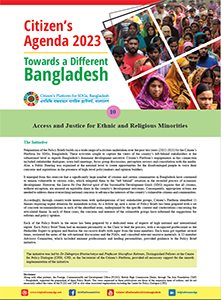 Background and Context
Background and Context
Bangladesh is home to a large number of ethnic and religious minority groups. They add to the country’s cultural richness and tapestry, making significant contributions to the country’s socio-economic development. However, these communities are facing persistent economic and social deprivations, resulting in their further marginalisation. Their access to justice and public services is also limited.
To note, religious minorities account for around 11 per cent of Bangladesh’s population. They include Hindus, Christians and Buddhists. Among these, the Hindu population has the largest share, accounting for more than 90.0 per cent of the minority population. Among the Hindus, there is a sub-group belonging to the lower caste, identified as Dalits, who constitute about 3 per cent of the population and are particularly discriminated against. Also, among the Muslim population, there is a small number of Shia Muslims as well as a minority Islamic sect, the Ahmadiyya Muslims. There are more than 54 ethnic minorities living in the plainlands and the hill tracts areas of Bangladesh. These diverse groups have a rich heritage and add to the country’s tradition and culture mosaic. The ethnic people speak in at least 35 languages, other than Bangla, and pursue their own traditional ways of living.
Throughout the history of Bangladesh, both religious and ethnic minority communities have played an important role in shaping the nation’s identity, contributing to socio-economic progress of the country. Despite this, the minority communities in Bangladesh have been facing a continuing stream of discrimination, leading to multidimensional disparities and constrained access to basic entitlement provisions.
Published: May 2024


Leave A Comment